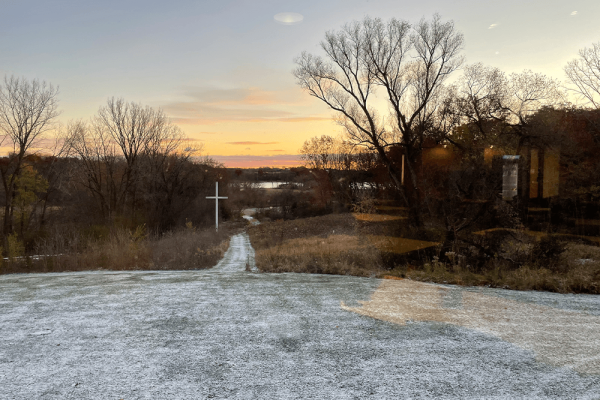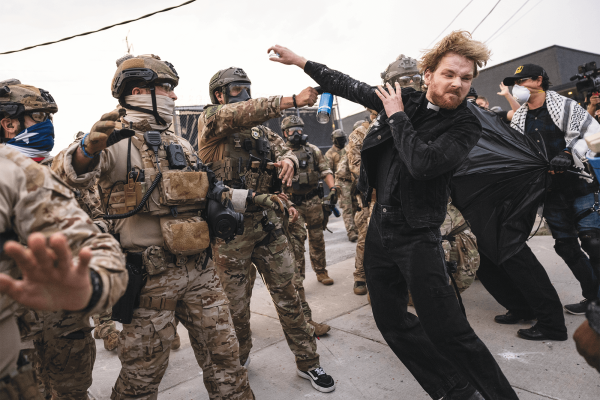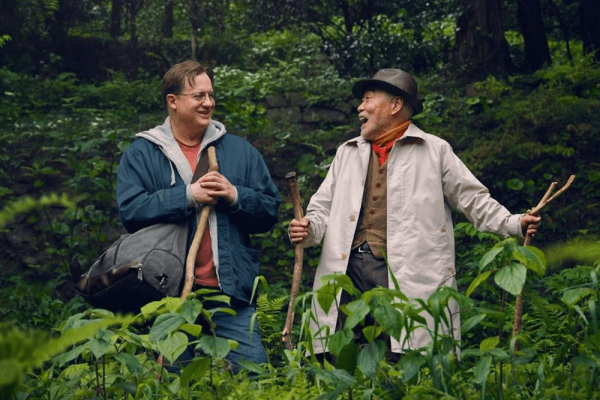MAPS ARE NOT just drawings of a place; they are also windows into a perspective. In the era of European colonial expansion, maps were essential tools.
The 15th century imperial edicts known collectively as the Doctrine of Discovery theologically and politically justified the brutal seizure of land not inhabited by European Christians. This set into motion a new worldview that is the basis for all modern property ownership and established a relationship to the land based on colonization rather than habitation. As a result of this and other political arrangements, the Roman Catholic Church controls about 177 million acres of land around the world.
Molly Burhans is a Catholic, an activist, and an entrepreneur. She is also a cartographer and geographic information system (GIS) analyst who sees the church’s landholdings as an opportunity for a global spiritual and ecological transformation. If church maps in the past too often represented cultural oppression and land domination, the maps Burhans creates are powerful tools for ecological regeneration and social repair.
In 2015, Burhans founded GoodLands, an independent nonprofit organization using GIS technology to help the Catholic Church leverage its landholdings for wise land-use decisions impacting climate change and related crises. After visiting the Vatican and receiving massive data sets on the church’s global landholdings, she presented the first global, data-based maps of church lands to Pope Francis.
Bringing the church’s maps online makes publicly accessible this unique visual data that both tells a story and invites action. The hundreds of maps in GoodLands’ Catholic GeoHub include visualizations of the church’s global carbon footprint, the dioceses with the greatest biodiversity, and projections of how a 5-foot sea level rise would affect the Boston Archdiocese.
Burhans’ commitment to the Catholic Church extends beyond environmental issues. In 2017 she volunteered her skills to BishopAccountability.org, a publicly available library of information on the Catholic clergy abuse crisis. Data that is accessible geographically can provide users with clearer policy options. In mapping the priest abuse cases, for example, Burhans was able to identify the policies that were most effective in protecting minors.
At 32, Burhans has amassed some unusual life experiences. She not only spent time in her 20s discerning a vocation to religious life inspired by the social justice work of Dorothy Day, Peter Maurin, and the Catholic Worker movement, she was also an Occupy Wall Street activist before co-founding a worker-owned aquaculture farming cooperative on vacant industrial land in her hometown of Buffalo, N.Y. Additionally, she was named a Young Champion of the Earth for North America by the United Nations and received Sierra Club’s EarthCare award in September. Today, the Connecticut-based GoodLands offers planning, map-making, and data systems services to landholders who care about the environment.
Élan Young (@YoungElan), who lives in eastern Tennessee, interviewed Burhans by Zoom in August 2021. This interview has been edited for clarity and length.
Élan Young: How do you see the mapping of land as integral to building ecological and social resilience?
Molly Burhans: Generally speaking, you need to understand the environment before you do environmental programs. Land is like a blueprint. You wouldn’t build a building without a blueprint. What I’ve seen over the years is there are some groups that really have gotten GIS fantastically, and they use GIS in a way to inform their programs. If you don’t, and I see this so often, people are like, “Oh, let’s plant 1,000 trees.” If you’re not planting the right trees in the right place, you’re wasting resources and potentially causing harm.
It’s about being smart about where you put your programs; it’s about understanding the context. Once you have that baseline of information, then it’s transformative. It allows you to not waste resources and allows you to multiply the impact.
How does the mission of GoodLands go beyond building climate resilience for the Catholic Church and its members? What I’ve known since the start is that Catholic is not a niche unless you’re doing something very Catholic, like a specific youth ministry or selling rosary beads or prayer cards or pilgrimages. Catholic Refugee Services serve everyone. Catholic health care serves everyone. It doesn’t matter if they’re Catholic or not. [It’s] built to serve with a preferential option for the poor. And ideally, and quite often, serves with excellence. Catholic environmental programs aren’t just Catholic. We have to think of them as serving not only the Catholic Church but anyone who comes to us—and serving with excellence and providing value for the entire world. That is the goal: excellent care for creation.
Behind climate resilience there must be foundational data. We realized that helping the Catholic Church actualize [the environmental encyclical] Laudato Sí and environmental impacts through conservation didn’t fit the traditional conservation business model. Conservation in the U.S. is largely motivated by the financial side, reducing taxes for donating land to conservation easements. But if you don’t pay taxes then it’s hard to incentivize. It’s hard to help an organization balance their books, even if their values are compelling them to do that work. We figured out that a new model had to be built, and it had to take into account a “triple bottom line,” which means accounting for a social impact, an environmental impact, and financial realities that can help support the implementation and realization of these programs.
We mapped every Catholic property in the U.S.—that was necessary to break open these conversations. We analyzed the data with green infrastructure mapping done in collaboration with environmental NGOs, the Environmental Protection Agency, and Esri [a maker of GIS software used by GoodLands].
Beyond the Catholic Church, and beyond climate, we’re hoping to figure out how to franchise or help other religious groups replicate our work. We’ve been approached by a large group of evangelicals. We’ve been approached by a coalition of Buddhist monks. I want to help them look at how we’ve understood our security and the “top-down and bottom-up” approach we use so they can do it themselves.
Is there a particular success story that you would like to highlight? We’ve done more than a dozen major projects that are highlighted on our website. We created the Catholic Geospatial Infrastructure—a geohub that supports open access to more than 300 data sets, apps, and maps that GoodLands has curated. We’ve done a green infrastructure assessment of all Catholic-affiliated properties held by the United States Conference of Catholic Bishops and a global biodiversity assessment of the Catholic Church. The vast majority of our work to date has been research and development to build interest. When I started, nobody even knew what a map was or wanted it. So, I had to go into religious orders at the start and say, “Hey, I’m going to do this for free for you if you want.” Thankfully, I had a great network of experts and volunteers. We had to get our foot in the door to do work that is environmental in any capacity.
Making the first global map of the Catholic Church really moved stuff forward. [In June] we saw the Vatican release its property portfolio. I personally was not in the room when that happened, but I would not have any shadow of doubt that my work has helped push that forward. My relations in Rome helped provide foundational data, which was necessary for all our other work. Now we know the pitfalls of working with a diocese in digital transformation where sometimes there’s not even an Excel spreadsheet.
There’s so much work to do with the land and with climate change, but what becomes clear over and over again is that the more we do to build this understanding of land and the potential to transform it in an informed way, the more the Catholic Church leadership in Rome really needs to understand geographic [information] standards, which is something every country has.
In 2017, I gave the Holy See a proposal for a cartography institute. In 2018, to my surprise, Pope Francis approved that I establish a trial institute. The approved setup lacked the resources for it to do what we knew needed to be done for my role to be effective in managing their global data with geographic standards. I sent a counteroffer, and now I’m waiting.
How do you respond to the concern about an over-reliance on technology in our quest to mitigate the climate crisis or come into balance with nature? Technology won’t solve anything if the human heart isn’t moved. We need what Pope Francis calls an “ecological conversion.” At the end of the day, nothing will change without that. That goes for any of the systems in which we are facing challenges—economics, capitalism, it doesn’t matter.
I’m not an expert in economics, but Pope Francis talks about that in addition to technology. We can all argue about which textbook theory is the best or which economic system to embrace, but at the end of the day, if we don’t deal with human greed, then it’s all going to fail. And same with technology. Looking at the response of anti-vaxxers, we know that presenting facts doesn’t change people. We need a conversion of heart and of mind. Without that, a technocratic paradigm is destined to be terrifying. So, the warning is fair. At the same time, the continuation of civilization will be enabled by using the best technology and most advanced science, novel collaborations, and creativity to reframe our relationship with nature.
Do you think the Catholic Church can move toward faithful transformative land use without addressing the Doctrine of Discovery and the generational trauma that results from land seizure and other colonial atrocities? No. Very easily, no—we cannot move forward. I have had listening sessions with Indigenous elders throughout the years. When the news broke about [large unmarked] graves found at residential schools [in Canada], I wept and recognized that my weeping was a fraction of the weeping of Indigenous peoples across [the continent] whose voices were not heard for generations, and who even now haven’t received a proper response from the Catholic Church.
If we are to heal the land and allow land to work for good, then we have to heal each other. Maps are great because you can have conversations about the palimpsest. The land is a palimpsest of our histories. And in these layers are buried atrocities of the past. Land is so difficult.
What does land restoration look like to you? I don’t like the phrase “land restoration.” I prefer the language of thriving. I say this notion of thriving because I think that’s how we have to think about ecosystem restoration. I don’t think restoration is a realistic idea, and I don’t like the term “ecosystems health” either. I use it all the time, so forgive me, but this has been kind of a thorn in my side. When you restore health to a person who was seriously ill, they are not the same ever again—psychologically, physically. In the Anthropocene, when I look at what we’re facing, I don’t think we know what a healthy ecosystem is.
So, what are we going to do? We have to figure out how to thrive—not to restore, but to regenerate. We are here to tend the garden, and we’ve messed it up tremendously. But at this moment, too, we have no choice but to figure it out. Tending the garden is a labor of love. It creates health. It’s a multiplier of every Christian impact and mission. I wouldn’t be Catholic if I didn’t believe Catholicism, but what I do see across faiths is a beautiful compulsion to love. And a fundamental truth of loving your neighbor is tending the garden.

Got something to say about what you're reading? We value your feedback!






